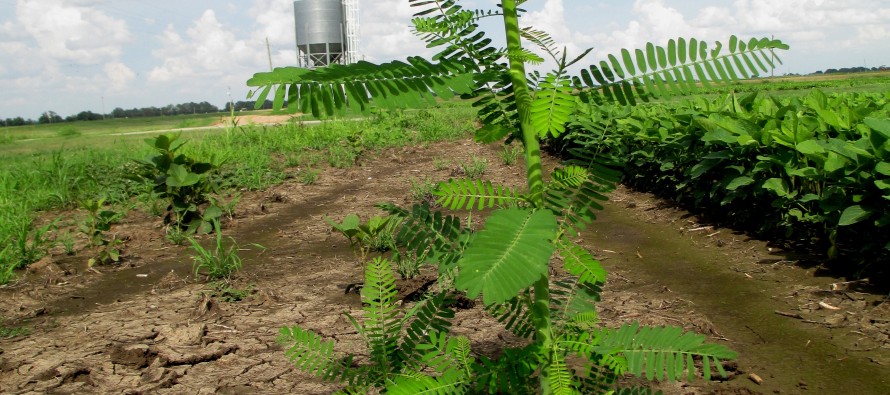Weed of the Week: Hemp Sesbania

Written by: Aly Shinkle, Jason Bond, and Tom Eubank
Hemp Sesbania
Family: Fabacea
Scientific name: Sesbania herbacea (Mill.) McVaugh
Synonyms: coffeebean; coffeeweed
Hemp sesbania is an erect, annual plant noted for prolific branching, large, yellow flowers, and distinctive curved seed pods. Cotyledons may appear lance or spoon-shaped with a simple first true leaf. Leaves are compound and contain 20 to 70 individual, opposite leaflets. Mature plants span from 3 to 13 feet in height. Hemp sesbania prefers moist soils, commonly observed growing in ditches and low-lying areas of fields. It is a major weed of rice in Mississippi and often emerges late in the season in rice and soybean fields. Late-emerging hemp sesbania is problematic at harvest due to its height, woody stem, and the fact that its black seed contaminate grain samples.
Bryson, C.T. and M.S. DeFelice. 2009. Weeds of the South. Athens, GA: University of Georgia Press. pp. 207.







A simple description to identify in the field. Is this also a problematic weed in corn crop? In India this is planted as a green manure crop and sometimes used as fodder crop.
Hemp sesbania can be problematic in corn in Mississippi. It would be found on poorly drained areas of fields.
how can u get rid of coffee beans in duck holes where u have corn,milo,millet,sunflowers,and aquatic weeds?-thanks(besides a disc)
Mike: It will be difficult to control hemp sesbania with the mix of crops that you have planted. Ultra Blazer or Aim will be effective at controlling the hemp sesbania. However, neither of these is labeled for application in all the crops you have in the mix. Depending on the maturity of the milo and sunflowers, I would expect them to be hurt the worst. You will see moderate to severe chlorosis on all crops with Ultra Blazer or Aim, but I do not think any of the crops will be harmed beyond cosmetic injury.
Our plantation managers having a terrible time with hemp sesbania in corn planted in former rice fields for ducks in South Carolina along the coast. Rice fields are adjacent our major rivers with quater drains every 100 feet. All ditches flow into our coastal rivers. Water quality issues & labels limit the herbicides they can use. Many are using a Roundup varities but the hemp “breaks through” after drydown. RR not good on help.
Any suggestions on pre or post emerge herbicides.
Thanks,
M Barnes
Plant rice the end of June to early July for ducks. The late maturity should help offset black bird predation. Drill seed rice if possible. Use a good pre-emergent like Command+glyphosate. One month after sprouting use Loyant at full strength It will kill Sesbania up to 2 foot tall. Fertilize and flood up ASAP after spray. You should be good to go… You can also use 24D when rice is between 6 to 8 weeks after sprouting. Be careful with it though you can burn the rice If you overdo it… with any herbicide READ THE LABEL carefully.
With the water issues, Ultra Blazer after dry down when they start blowing up is the best plan we can come up with. Try to make application prior to blooming on hemp sesbania.